BIS Certification for Specification for Hot Rolled Steel Strip (bailing) IS 1029: 1970

Product Description
BIS Certification
for Specification for Hot Rolled Steel Strip (Bailing) IS 1029: 1970 is all
about making sure that steel strips live up to Indian safety and quality
standards. This certification confirms that the products meet the requirements
laid out in IS 1029: 1970, which details the technical criteria for hot-rolled
steel strips used in baling applications.
By obtaining this certification, manufacturers can boost product reliability, making their steel strips perfect for both industrial and commercial needs. Plus, having BIS Certification for Hot Rolled Steel Strip (Bailing) IS 1029: 1970 helps manufacturers gain acceptance in the market and stay compliant with regulations while also building customer trust in the quality of their products.
Introduction
Getting BIS
Certification for the Specification of Hot Rolled Steel Strip (bailing) IS
1029: 1970 is key to meeting the Steel & Steel Products (Quality Control)
Order, 2024. This certification is a must for manufacturers looking to sell and
distribute hot-rolled steel strips in India. It confirms that the steel meets
specific mechanical and chemical properties, making it reliable for various
industrial uses. We offer expert consultancy to guide you through the BIS
Certification process for Specification for Hot Rolled Steel Strip (bailing) IS
1029: 1970, helping you navigate compliance with ease and ensuring you can
access the market smoothly.
Why is BIS Certification necessary for Specification for
Hot rolled steel strip (bailing) IS 1029: 1970?
Getting BIS certification for the Specification for Hot Rolled Steel Strip (Bailing) IS 1029:1970 is important. It helps ensure that the products are of high quality, safe to use, and compliant with Indian standards. This certification means that the steel strips have the right mechanical and chemical properties, which is key for their durability and reliability in various industrial applications. Plus, it builds trust with consumers and makes it harder for substandard products to slip into the market.
For businesses,
securing the BIS Certification for Specification for Hot Rolled Steel Strip
(Bailing) IS 1029: 1970 is critical. It allows them to meet regulatory
standards, boosts product credibility, and gives them a leg up in the
competitive steel industry.
Overview of Indian
Standard IS 1029: 1970
IS 1029: 1970 outlines
what you need to know about hot-rolled steel strips for bailing applications.
It goes into details like the chemical makeup, mechanical properties, sizes,
and measurement tolerances, all to ensure top-notch quality and performance.
This standard is designed to guarantee that the material can hold up to the durability
and strength demands of industrial use. To ensure compliance, BIS Certification
for Specification for Hot Rolled Steel Strip (bailing) IS 1029: 1970 is
mandatory. This certification helps meet safety and quality standards.
Manufacturers need to go through testing and certification to align with BIS
standards, which boosts product reliability in the marketplace.
Process for BIS Certification
The BIS certification process for Specification for Hot rolled
steel strip (bailing) IS 1029: 1970—involves multiple steps designed to
thoroughly evaluate a product's compliance with the required standards. Here is
a general overview of the certification process:
1. Application Submission:
Manufacturers must submit an application form along with the required documentation
to BIS.
2. Documentation Review: BIS
reviews the submitted documents to ensure completeness and correctness.
3. Factory Inspection: BIS
officials conduct an on-site inspection of the manufacturing facility to assess
the production process and quality control measures.
4. Sample Testing: Product samples
are taken and tested in BIS-approved laboratories to verify compliance with
Indian standards.
5. Certification Grant: Upon
successful completion of the inspection and testing, BIS grants certification,
allowing the manufacturer to use the BIS mark on their products.
Documents Required for BIS Certification
To apply for BIS certification, manufacturers need to submit the following documents:
● Application form
● Manufacturing process details
● Quality control plan
● Test reports from BIS-approved laboratories
● Factory layout and equipment details
● Proof of business registration
● Product specifications and technical details
● Declaration of conformity to Indian standards
Additionally, manufacturers may be required to provide proof of compliance with environmental and safety regulations, depending on the specific type of product being certified.
BIS ISI Mark Certification Costing And Timeline
To Know The Process in Detail, Please Visit:
Under BIS Registration Products ISI and CRS
Conclusion
At EVTL India, we’re
all about helping you navigate the world of BIS Certification for Specification
for Hot Rolled Steel Strip (bailing) IS 1029: 1970. Our consultancy services
ensure that your products meet Indian standards for quality, strength, and
performance—key requirements for safe use in various industrial applications.
Our dedicated team works closely with businesses to make the certification
process as smooth as possible, covering everything from paperwork to testing
and final approval. With our deep expertise, we make it easier for
manufacturers to achieve BIS compliance efficiently, boosting their products'
credibility in the market.
When you choose EVTL
India for BIS Certification for Specification for Hot Rolled Steel Strip
(bailing) IS 1029: 1970, you’re opting for a reliable partner that simplifies
your regulatory journey. We cut through the red tape, ensuring you meet all
mandatory standards without unnecessary delays. Reach out to us today and let
us help you confidently meet BIS requirements, making the whole process
hassle-free.
Free Call Back
Latest News & Update
📅 BIS Critical Component List (CCL) Updates for Solar PV Modules
🕒 BIS Fee Concessions for MSMEs and Startups | EVTL India
📅 Guidelines for Implementation of Essential Requirements for Security of CCTV
🕒 Machinery and Electrical Equipment Safety (Omnibus Technical Regulation) Order, 2024
🕒 Extension of Timeline for Filing Annual Returns by Battery Producers
📅 Extension of Timeline for Filing Quarterly and Annual Returns for E-Waste
🕒 Extension of Concurrent Running Period for IS 302-1: 2008 and IS 302 (Part 1): 2024























